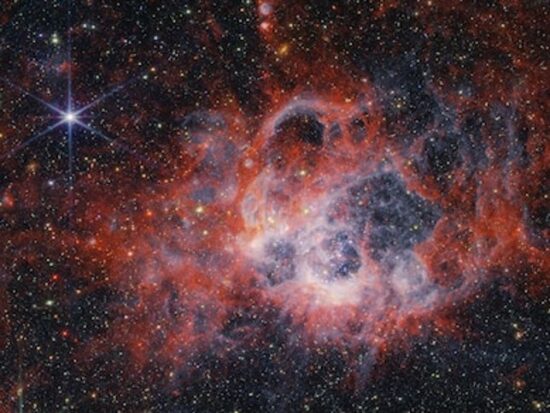The James Webb Space Telescope (JWST) tells us that the physics we trust to explain the Universe as we understand it is not quite right. The controversy begins with the Hubble Constant (HO), a calculation of the Universe’s expansion rate which we use to determine its age.
The H in HO represents Edwin Hubble who in 1929 was the first to observe the rate of expansion. The O equals zero, the present starting point. The calculation of HO uses different methods.
- Cosmic Microwave Background measurements yield a value of approximately 67 km/s/Mpc.
- The Hubble Space Telescope’s calculations yield a value of approximately 74 km/s/Mpc.
- The Red giant star method produces a value of approximately 69.8 km/s/Mpc.
- The JWST produces a value of approximately 69.96 km/s/Mpc.
- Gravitational lensing has been used to come up with a value of 75.4 km/s/Mpc.
So what’s the big deal between a measure of 67 and 75.4 km/s/Mpc? It turns out to be a very big deal when you consider a megaparsec is 3.26 million light-years, a huge distance. For a point of reference, the nearby Andromeda Galaxy, our Milky Way twin is currently 0.89 Mpcs distant or 2.9 million light-years and the two are converging at a rate from 110 to 300 km/s depending on who is making the calculations (again a huge discrepancy).
The difference in these calculations is referred to by physicists, mathematicians and cosmologists as the Hubble Tension. It challenges their fundamental understanding of the physics that governs the Universe. The discrepancies aren’t trivial. Differences in mathematical calculations have caused missions costing hundreds of millions of dollars to crash on places like the Moon and Mars.
To cause even more confusion, in 1998, two teams of astronomers discovered that the HO wasn’t a constant but rather was accelerating. The predominant explanation for this observation was a new force in the Universe called dark energy, a form of antigravity, that could explain why large objects like galaxies and galaxy clusters were moving further apart from each other at accelerating rates. Soon the dark energy explanation was joined by others including:
- The existence of the Metaverse suggests many other universes with regular collisions and mergers.
- Mathematicians in reviewing the equations behind Einstein’s General Relativity believe he predicted cosmic acceleration caused by the existing structure of the Universe itself.
- Some scientists argue the Universe is not homogeneous and different parts are expanding at different rates which can explain the current distribution of the galaxies.
- Some believe Einstein’s theory of general relativity is incomplete and needs a refresh to to understand the forces of gravity on a cosmic scale.
- Some argue that the speed of light hasn’t been a constant and that in the early Universe, it was different.
- Some propose that quantum gravity effects can have a larger influence than previously hypothesized when determining cosmic expansion.
- Some scientists propose a period of dark energy dominating the early Universe causing the birth of a multitude of bright and short-lived galaxies and spurring faster acceleration.
Today, based on the Hubble Space Telescope’s observations with JWST confirmations using the regular pulsations of Cepheid variable stars the current calculated age of the Universe is 13.8 billion years. That measure seems to be backed by a common consensus in the scientific community. But the Hubble Tension remains a conundrum.
Dark energy remains the leading contender in explaining the accelerated expansion. It is calculated as comprising almost 70% of the Universe’s total mass-energy, Einstein’s famous equation E = mc².
Dark energy, rather than existing in the earliest stages of the Universe, is seen as having come into force only halfway through its history. Its nature is unknown. It is not observable or measurable. Some cosmologists argue it is the energy of space itself.
What does its existence and effects imply? If the expansion of the Universe continues to accelerate all of the structures not gravitationally bound will eventually recede beyond our ability to see them. Our local galaxy cluster including Andromeda and others will remain visible to us billions of years in the future but the rest of space will become a black void.










Why do the disparate expansions rate methods all give a single number? If expansion is accelerating over time, then further away observations should show slower expansion, and closer objects accelerated expansion. So each method should show multiple readings of the expansion rate, depending on the distance used.
Then the true ” tension” would apply, or not, to those common numbers measuring expansion at the same distance with various methods that allow that overlap. Also one would think we would also know the acceleration rate for each measurement technique?
Also, especially over billions of light years, the light reaching our earth’s must have passed through far more clouds of unknown gases, and perhaps galaxies, which are long since moved out of path between the earth and those star observations. So we have no idea how that light was potentially affected ( red shifted) by those encounters. The further the object, the greater the likelihood of an adjusted red shift due, not to expansion, but from spectrum shift due to disparate materials encountered. Would this not create a greater then appearance of greater red shift over distance, potentially due to more materials encountered vs accelerating expansion?
Thanks for consider
All the Best…
DA
Clarification to the last sentence.
The further away the measured is measured, the more the redshift is exaggerated by encountered unknown materials, meaning those old or distant objects are in fact less redshifted by expansion then observed, meaning the expansion rate was in fact slower then indicated by the polluted redshift?
Anti-gravity is a nice idea by falls far short of the ordinary reason for our expanding universe.
In 1997 I published in peer review my paper STRETCHED AND NEAR ZERO SPACE-TIME, A New Model of Graviation and Black Hole Dynamics. In it I redesigned the Black Hole from the timeless void of Einstein’s work to one in which time did exist and in which Big Bangs are an inevitability, as black hole have a size limitation.
Also I explained that the Univers must expand at an accelerating rate of speed that is different for different masses. Not due to any new discovery but because each layer of quanta that leaves the Black Hole have different amounts of Kinetic Energy.
THE LAWS OF DIMINISHING AND NEGBATIVE RETURNS.
Graviation is a natural force, therefore it obeys these two laws. As the hole takes in each unit of mass, gravitation increases in kind 1 to 1. However, eventually Diominishing Returns is reached. Now for each unit of mass taken in by the hole gravitation increases by a smaller and smaller amount, until Negative Retursn is reached and the Big Bang begins.
The quanta in the hole, as all quanta do, have a unique resonance frequency at which they vibrate. They are active particles, this is their nature! But in the Hole gravitational compression is so great, that they cannot vibrate. They try to, they constantly push against the compression, but the gravitational compression is too great. In the Hole quanta are quantum potentials, reduce to merely being quantum springs, pushing against gravity.
This expansive force of the quanta is the power behind the Big Bang, and what a power it is.
Think of it, all the mass of our universe compressed into an area the size of an NBA basketball! When Negative Returns is reach all that energy is released. Mass and space-time itself go shooting off at super light speeds…but not all the mass and space-time do.
(Note, since space-time is also expanding out of the Black Hole with the quanta, the quanta, within their own space-time, are not moving at super light speeds, even though to an outside observer they are traveling at super light speeds).
ALL MOVMENT IS A NET FORCE.
Look at the Hole as an onion with layers of quanta.
The top most layer, springs off of the second layer. The second layer springs off teh third layer, the third layer springs off the fourth, and so on. The Top layer gets a bit of a boost from the second layer and so has a bit more Kinetic energy. The thrid layer has two layers of quanta pushing back on it, taking a bit of its kinetic energy, and so it has a bit less kinetic energy than the second layer. The Fourth layer has 3 layers pushing back on it and so has a bit less kinetic energy than the thrid layer. This goes on for each layer as we go deeper into the hole.
As were go towards the center of the Hole, we reach the Median Quanta Layer. Here, the force of the outer layers pushing back is equal to the inner layers pushing outwards. This is our Black Hole remnant. This layer of quanta will never leave the Hole.
The next layer out has a bit of kinetic energy and will leave teh Hole, but it won’t go far, and then it will fall back into the hole. Each outer most layer will go a bit farther than the next inner layer does, and fall back into the hole in a mini crunch.
Eventually as we pass through the outer layres, we reach the Escape Velocity Layer (EVL). These Quanta have enough kinetic energy to cross the gravitational boundary of the Hole, but they use the last of their kinetic energy to do so and stop. They sit there until acted upon by an outside force. To an outside observer, these quanta have been slowing down ever since
they left the hole.
The next layer outside of the EVL has a bit of kineit energy left over when it crosses the gravitational boundary. Rather than stop, it stops slowing down and now proceeds at a uniform rate of speed equal to the amount of kinetic energy it has left.
Each layer had more and more kinetic energy left after crossing the gravitational boarder and so expands at a faster speed.
As we pass through the outer layers we come to the 2X Layer. This Layer has twice teh kinetic energy needed to escape gravitation. When it crosses the gravitational boundary it has half of its kinetic energy left. To an outside observer, this layer has been traveling as a uniform speed since leaving the Black Hole. Once it crosses the gravitational boarder i continues traveling at this uniform speed.
The layers outside the 2x Layer are the Super X Layers. They have more than twice the kinetic energy needed to escape the Black Hole. For each unit of distance traveled, the gravitational pull has decrease at a greater rate than the quanta’s kinetic energy has decreased. Thus, its Kineitc Energy has gotten greater relative to the gravitational constrant.
To an outside observer, these particles have been accelerating in speed as they have moved out from the Black Hole, getting faster and faster. When these cross the gravitational boarder they too will stop accelerating and then proceed at a uniform speed equal to their remaining kinetic energy.